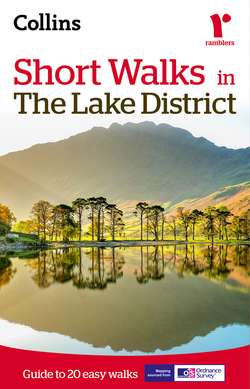Читать книгу Short walks in the Lake District - Collins Maps - Страница 7
What is the Lake District?
ОглавлениеWhat is seen now in the Lake District still reads historically from north to south. The mountains and hills of Skiddaw Slates which lie in a curving band, from the north to the west, are covered by carboniferous limestones and sandstones nearer the coast, and reappear to the southwest at Black Combe. Because much of this material is shaley and craggy outcrops seldom occur, the fells have angular outlines. Typically of course there is Skiddaw itself (3054ft/931m) with its neighbour Blencathra (2847ft/868m). The fells to the west of Derwentwater, Causey Pike and Grisedale Pike, are of the same material, and the rock is also very evident in the fells on the east side of Buttermere, to the north and west around Crummock Water and Loweswater as well as the northern end of Ennerdale Water. There is good soil depth on these rock forms which allows trees and heather to grow naturally.
In the central Lake District, roughly north-east to south-west are the high craggy fells of the Scafells, Great Gable, the Borrowdale fells, as well as Coniston Old Man in the south-west through the Langdales and Bowfell; and eastwards through Helvellyn to High Street. Here, the shallow acidic soils do not support a rich vegetation. The alpine plants are found mainly where springs leach the minerals to the surface. The deeper soils are often covered in bracken, very beautifully coloured in autumn, but useless to the hill farmers’ sheep. From another type of rock, formed from fine volcanic sediments in water, comes the famous green slate, still quarried and much in demand for its wearing and decorative qualities. It is used for the facings of prestigious buildings. The Honister Slate Mines on the Honister Pass closed in 1986 after three centuries of production. However, it reopened in 1997 as a working slate mine and has become one of the leading attractions in the Lake District.
In the south of the Lake District the soft slates and mudstones produce an acid soil in which trees and forests find root and regenerate quite readily. The typical scenery, much in evidence around Windermere, consists of rounded hills, often with a good deal of tree cover. The Forestry Commission’s largest forest, at Grizedale is also in this area.
Before there was a substantial human settlement the whole area was covered in forest. This has been removed over a period of 4,000 years. Much of it was destroyed from early Elizabethan times up to the end of the 19th century to provide charcoal for iron furnaces. The increase in sheep grazing has meant that regeneration has been impossible. Much of the woodland and forest we now see was planted within the last century and a half. The lack of tree cover in many places has accelerated erosion and impoverished the soil.
